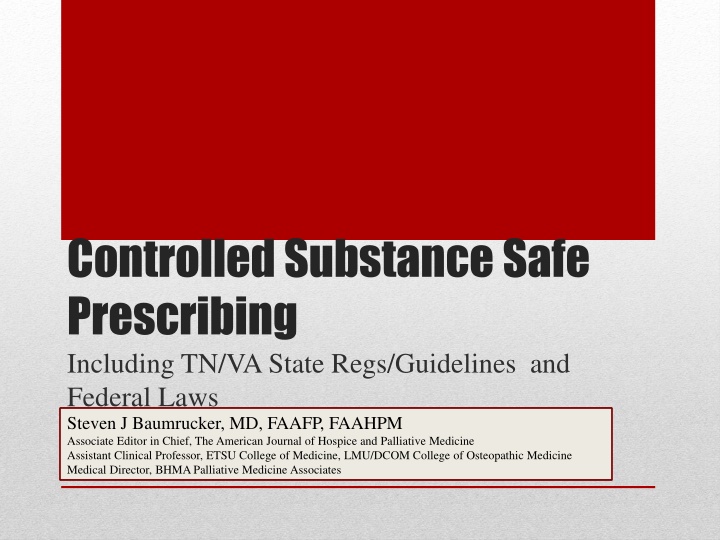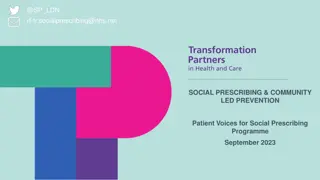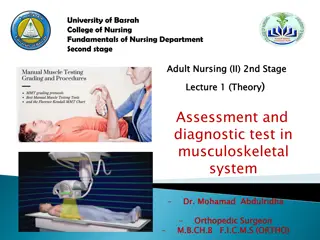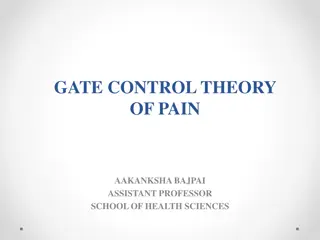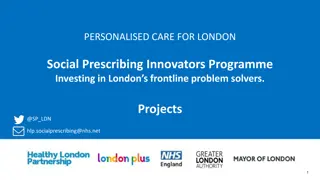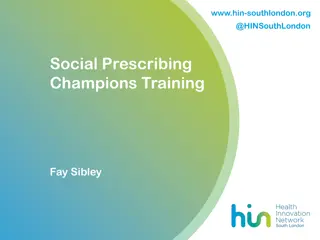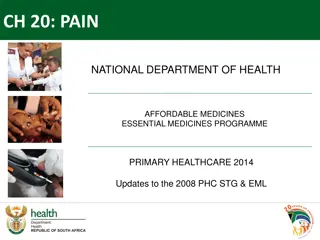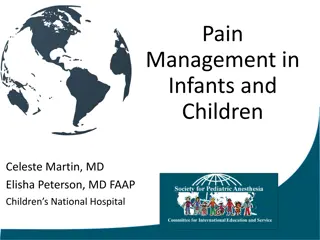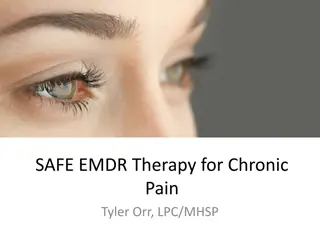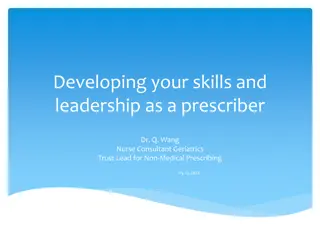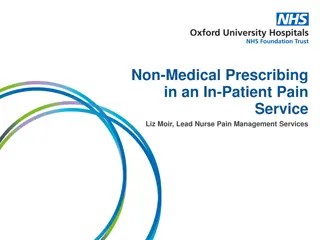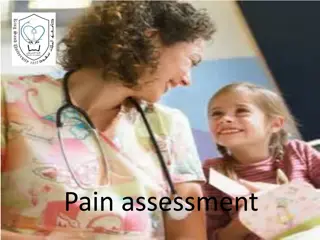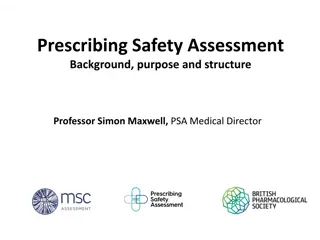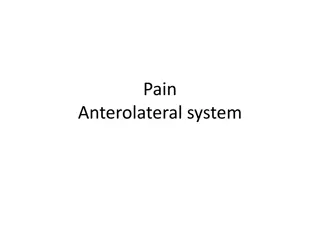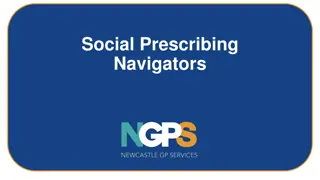Controlled Substance Safe Prescribing and Timely Pain Treatment Guidelines
Timely and appropriate treatment for pain is crucial, improving function and quality of life. These guidelines aim to address chronic pain, avoid addiction, and reduce adverse outcomes through interdisciplinary approaches and non-opioid modalities. With a focus on morphine equivalent daily dosing and state regulations, the goal is to combat the opioid crisis and enhance patient care for those suffering from acute and chronic pain.
Download Presentation

Please find below an Image/Link to download the presentation.
The content on the website is provided AS IS for your information and personal use only. It may not be sold, licensed, or shared on other websites without obtaining consent from the author.If you encounter any issues during the download, it is possible that the publisher has removed the file from their server.
You are allowed to download the files provided on this website for personal or commercial use, subject to the condition that they are used lawfully. All files are the property of their respective owners.
The content on the website is provided AS IS for your information and personal use only. It may not be sold, licensed, or shared on other websites without obtaining consent from the author.
E N D
Presentation Transcript
Controlled Substance Safe Prescribing Including TN/VA State Regs/Guidelines and Federal Laws Steven J Baumrucker, MD, FAAFP, FAAHPM Associate Editor in Chief, The American Journal of Hospice and Palliative Medicine Assistant Clinical Professor, ETSU College of Medicine, LMU/DCOM College of Osteopathic Medicine Medical Director, BHMA Palliative Medicine Associates
Timely and appropriate treatment for pain Improves Ability to function Quality of life Intended to support clinicians in treatment of chronic pain Avoiding Addiction Adverse outcomes Since creation of the guidelines 12% drop in total morphine equivalents Pain clinics decreased from 333 to 188 However, overdose deaths continue to increase Purpose of the Guidelines
MEDD PO MorphineEquivalent Daily Dose MME Morphine Milligram Equivalent CSMD Controlled Substances Monitoring Database Some Baseline Information
Defined as pain lasting longer than 90 days Requires and interdisciplinary process Many non-opioid modalities Physical therapy Psychology Non opioid medications Steroids Anticonvulsants Antidepressants SNRI Chronic Pain
In 2015, TN was second in the country for opioid scrips Unchanged from 2011 Unintentional overdose Increased 250% from 2001 to 2015 Eclipsed MVA, Homicide, Suicide in 2015 Neonatal Abstinence Syndrome grew 10-fold 2001-2011 Five fold increase in Worker s Comp cases for opioid abuse Chronic pain still needs treatment 116 million US adults suffer from chronic pain Why Is This Necessary?
Acute and chronic pain Among the most common reasons For physician visits For taking medication For work disability Affects physical and mental functioning Quality of life Productivity Pain
Opioid Addiction is rare in pain patients Physicians allow patients to suffer needlessly because of opiophobia Opioids are safe and effective for chronic pain Opioid therapy can be easily discontinued Industry Influenced Education
Rate of Rx Painkiller Sales, Deaths and Substance Rate of Rx Painkiller Sales, Deaths and Substance Abuse Treatment Admissions (1999 Abuse Treatment Admissions (1999- -2010) 2010) Source: National Vital Statistics System
Top 1% of States that sell prescription pain medications Top 10 for deaths by overdose Unintentional Drug overdose Number one cause of death in TN Over motor vehicle accidents, homicides Peak age 40-49 Providers prescribed 17 opioid scrips per capita National average=12 TN Ranks Highly in
NSAID-associated serious upper GI adverse events result in 103,000 hospitalizations and 16,500 deaths per year in the United States alone. Singh G, Rosen Ramey DR. J Rheumatol Suppl. 1998;51:8-16. Reality Check
Since starting the comprehensive strategy in TN to change the culture of prescription drug abuse 50% decrease in MEDD from 2012 to 2018 75% reduction in doctor shopping 20% decrease in neonatal abstinence syndrome Reduction in average MEDD of patients taking chronic opioids Some Successes
Improve Symptoms Improve Functioning Improve Quality of Life Minimize adverse effects, including death Minimize addiction Long Term Goals of Pain Management
Not applicable to End of life care Acute pain Emergency Room Hospital Patients Not meant to Dictate medical decision-making Generally Accepted guidelines and not absolutes Providers have flexibility to deal with exceptional cases Occasional deviation for appropriate reasons is to be expected What the Guides are Not
Prior to Initiation Key Principles, Initial Evaluation, Assessment, Goals for Treatment
Prescription by another provider is not a reason to continue opioids Reasonable non-opioid treatments should be tried All newly pregnant women should have UDS Discuss birth control to prevent unintended pregnancy in every woman of child-bearing age Document Hx, PE, Database prior to starting opioids Chronic pain shall not be treated [with opioids] through telemedicine. Key Principles
H&P Nature, intensity, past and current Rx Comorbid conditions Effect on FUNCTION Work Relationships Sleep Recreation Initial Evaluation
Review of prior records DIRECTLY RELATED to patient s CHRONIC PAIN CONDITION Just saying I have arthritis is not sufficient Prescribers have had difficulty justifying some diagnoses before the BME Well, they TOLD me theyhad cancer. Remember, another prescriber writing pain medications is not in itself justification to continue them Records Review
Evaluate for conditions that may result in adverse events Age COPD OSA DM CHF Renal Failure Morphine Co-Morbid Conditions
Initial, condition-appropriate physical exam Confirm diagnosis? Physical Exam
Consider screening for Depression Anxiety Current or past substance abuse Address these in the treatment plan Screening for Mental Health
Scoring: Count the points and total the score. The possible range is 0-27. Minimal depression 0-4 may not need depression treatment Mild depression 5-9 Physician uses clinical judgment Moderate depression 10-14 Physician uses clinical judgment Moderately severe depression 15-19 Severe depression 20-27 Warrants treatment for depression, using antidepressant, psychotherapy and/or a combination of treatment. Scoring the PHQ-9
The prescriber shall assess the patients risk for misuse, abuse, diversion and addiction. The prescriber should obtain a urine drug screen The prescriber shall check the Controlled Substances Database (tncsmd.com) The prescribing of opioids shall take risk assessment information into account Assessment of Risk for Abuse
DIRE Diagnosis, Intractability, Risk, Efficacy Score Numerical Score Categorizes patients into Not suitable vs Good candidate http://bit.ly/1DSaHVx Risk Assessment Tools
SOAPP-R Screener and Opioid Assessment for Patients With Pain- Revised 24 item, patient completed Widely used Impulsivity, legal, PHx, past sexual abuse (risk factor) Classifies Low and High Risk http://bit.ly/1FPqjPA Risk Assessment Tools
There shall be the establishment of a current diagnosis that justifies a need for opioid medications. Establish a Diagnosis
Primary goal of treatment should be clinically significant improvement in function. Treatment plan must also Include other treatments beyond opioids Pharmacological and non-pharmacological Provider should make reasonable attempts to implement this plan Counsel the patient Goal is to increase function and reduce pain NOT eliminate pain documentation of this discussion shallbe included in the medical record. PEG Assessment PAIN Average Interference of ENJOYMENT of life Interference with GENERAL activity Goals for Treatment
Initiating Opioids For Management of Chronic Non-Malignant Pain
Risk of overdose starts at 40 MEDD in opioid nave patients Greatest risk in first 2 weeks Risk for all patients increases 10-fold at 100 MEDD Absolute vs relative risk 1451 died from drug overdose in 2015 64559 total deaths in TN 2% of all deaths Absolute risk is therefore 2%-.2% or 1.8% or .018 Therefore the NUMBER NEED TO HARM: The inverse of 0.018 55 patients at >100MEDD Risk of Overdose
Maximum of 4 breakthrough doses/day If more are needed, simply document why Methadone shall be prescribed only by a pain medicine specialist Prescribers shall not prescribe buprenorphine for chronic pain If opioid >= 120mg PO Morphine Equivalents/day A mental health professional must assess necessity for any concomitant benzodiazepine prescriptions Should treatment deviate from the guidelines Simply document the reasons in the medical record Key Principles
Short acting Incident pain Acute pain Short-term treatment Mild pain Long acting Less of a peak effect Chronic pain requiring round the clock dosing ONE long-acting, ONE short-acting Short-acting MEDD should never be more than 50-100% of the long-acting. Basics of Opioid Therapy
Sustained release Morphine 30mg PO BID Breakthrough dose Immediate Release morphine 7.5 15mg PO QID prn LA = 60 MEDD SA = 30-60 MEDD Example
IV 30 10 Morphine/hydrocodone Oxycodone Morphine 20 10 Oxymorphone 7.5 1.5 Hydromorphone Calculating MEDD
Patient is on oxymorphone ER 20mg PO BID and hydromorphone 4mg PO QID prn MEDD= 40mg PO oxymorphone x 30mg PO Morphine/10mg PO oxymorphone = 120mg PO Morphine/day 16 mg PO hydromorphone x 30mg PO morphine/7.5mg PO hydromorphone = 64mg PO morphine/day TOTAL MEDD = 64+120 = 184 mg PO morphine/day Example
Initiation should be presented as a therapeutic trial Opioid na ve? Use lowest dose and titrate to effect INFORMED CONSENT must be obtained See sample informed consent Risks, alternatives and benefits Likelihood of dependence, risk of oversedation Pregnancy Risk of impaired motor skills, addiction and death Written treatment agreement Upon Initiating Opioids
Reasons for discontinuation of controlled substances Practice policy on early refills Policy on lost prescriptions Use of one pharmacy Periodic drug testing Female patients will tell the provider if they want to avoid unintended pregnancy and if they become pregnant See sample treatment agreement Written Treatment Agreement
Practitioners may provide a bridge of opioids For up to 6 months While assessment process is carried out No provider is obligated to continue opioid therapy that has been initiated by another provider If the initial evaluation does not support opioid use Discussion about risk and possible treatment of withdrawal Document with clinical reasoning for cessation Opioid Bridge
Providers must continually monitor patients for signs of Abuse Misuse Diversion Improvement of underlying condition Document improvement in Physical Functioning Psychosocial Functioning Drug Screening should be done twice a year (minimum) Reassessment
The providershould discuss methods to prevent unintended pregnancy Signed informed consent stating a woman has been educated about the risks of opioid treatment during pregnancy Pregnancy test prior to initiation should be done in all at- risk women Ask about pregnancy at each visit Consider long-acting reversible contraceptive Consider referral to high risk OBGYN if appropriate Women s Health
Ongoing Opioid Rx For Chronic Non-malignant Pain
Chronic opioid therapy should be handled by a single provider Prescriptions should be filled in a single pharmacy Use the lowest effective dose NO MORE THAN ONE SHORT-ACTING OPIOID Document The Five As Analgesia Activities of Daily Living Adverse effects Aberrant behavior Affect Key Principles
State recommends that patients on >120 MEDD should be referred to a pain specialist Consultation vs management If not done, document why Monitor patients for abuse UDS at least twice a year Document pill counts Check the CSMD/PMP and document in the chart Ongoing risk assessment Stop opioid therapy if the risks outweigh the benefits Taper if indicated Refer to addiction treatment program if appropriate Ongoing Therapy
